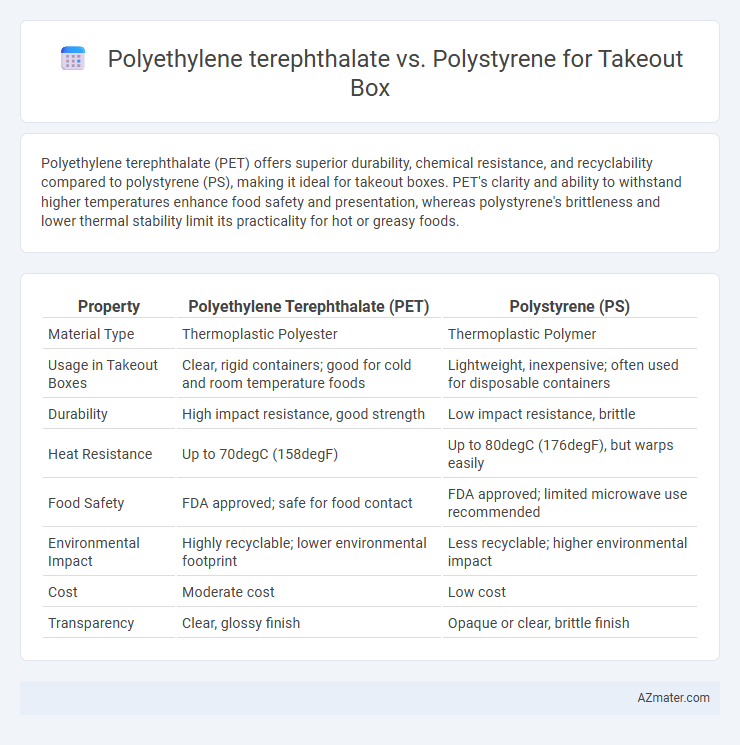Polyethylene terephthalate (PET) offers superior durability, chemical resistance, and recyclability compared to polystyrene (PS), making it ideal for takeout boxes. PET's clarity and ability to withstand higher temperatures enhance food safety and presentation, whereas polystyrene's brittleness and lower thermal stability limit its practicality for hot or greasy foods.
Table of Comparison
| Property | Polyethylene Terephthalate (PET) | Polystyrene (PS) |
|---|---|---|
| Material Type | Thermoplastic Polyester | Thermoplastic Polymer |
| Usage in Takeout Boxes | Clear, rigid containers; good for cold and room temperature foods | Lightweight, inexpensive; often used for disposable containers |
| Durability | High impact resistance, good strength | Low impact resistance, brittle |
| Heat Resistance | Up to 70degC (158degF) | Up to 80degC (176degF), but warps easily |
| Food Safety | FDA approved; safe for food contact | FDA approved; limited microwave use recommended |
| Environmental Impact | Highly recyclable; lower environmental footprint | Less recyclable; higher environmental impact |
| Cost | Moderate cost | Low cost |
| Transparency | Clear, glossy finish | Opaque or clear, brittle finish |
Introduction to Food Packaging Materials
Polyethylene terephthalate (PET) and polystyrene (PS) are widely used materials in food packaging, particularly for takeout boxes due to their distinct properties. PET offers high clarity, excellent barrier resistance to moisture and gases, and strong mechanical durability, making it suitable for preserving food quality and extending shelf life. Polystyrene provides lightweight, cost-effective solutions with good insulation properties but is less resistant to heat and impact compared to PET, influencing its use primarily for short-term or cold food packaging applications.
Overview of Polyethylene Terephthalate (PET)
Polyethylene terephthalate (PET) is a highly versatile thermoplastic polymer widely used in takeout boxes due to its excellent clarity, strength, and barrier properties against moisture and gases. Its chemical resistance and recyclability make it an environmentally preferred choice over polystyrene, which tends to be more brittle and less sustainable. PET's impact resistance and lightweight nature contribute to its popularity in food packaging, ensuring product safety and extended shelf life.
Overview of Polystyrene (PS)
Polystyrene (PS) is a lightweight, rigid thermoplastic commonly used for takeout boxes due to its excellent insulation properties and cost-effectiveness. It offers good clarity and can be easily molded into various shapes, making it ideal for disposable food containers. However, PS is less resistant to heat compared to polyethylene terephthalate (PET), limiting its use with hot foods or microwaving applications.
Physical Properties Comparison
Polyethylene terephthalate (PET) exhibits superior tensile strength and impact resistance compared to polystyrene (PS), making PET more durable for takeout boxes that require handling and stacking. PET has a higher melting point around 250degC, allowing for better heat resistance and microwave safety, whereas PS typically melts near 240degC and is more prone to deformation under heat. Additionally, PET offers improved clarity and chemical resistance, enhancing food safety and packaging aesthetics compared to the more brittle and less transparent polystyrene.
Thermal Resistance and Heat Tolerance
Polyethylene terephthalate (PET) offers superior thermal resistance compared to polystyrene (PS), with a heat tolerance typically up to 230degF (110degC), making it suitable for hot food applications in takeout boxes. Polystyrene's heat tolerance is generally lower, around 176degF (80degC), which can cause deformation or release of harmful chemicals when exposed to high temperatures. For takeout containers requiring exposure to hot meals or microwave use, PET ensures better durability and food safety due to its enhanced thermal stability.
Food Safety and Chemical Migration
Polyethylene terephthalate (PET) exhibits superior food safety for takeout boxes due to its low chemical migration rates and resistance to acidic and fatty foods, minimizing contamination risks. Polystyrene (PS), particularly in foam form, is more prone to leaching styrene monomers, especially when exposed to heat or oily substances, raising concerns over potential toxicity. Regulatory agencies often favor PET for food contact applications given its established safety profile and stringent migration limits compared to polystyrene.
Environmental Impact and Recyclability
Polyethylene terephthalate (PET) offers superior recyclability compared to polystyrene (PS), with PET widely accepted in curbside recycling programs and capable of being recycled into new containers and textiles. Polystyrene, particularly in foam form, has a significant environmental impact due to its low recycling rates and tendency to persist in ecosystems as litter, contributing to pollution and harming wildlife. The production of PET generally results in lower greenhouse gas emissions than PS, making PET a more environmentally sustainable choice for takeout boxes.
Cost and Manufacturing Considerations
Polyethylene terephthalate (PET) offers cost-effective manufacturing for takeout boxes due to its recyclable nature and compatibility with high-speed thermoforming processes, reducing production expenses. Polystyrene (PS), while cheaper in raw material cost, often incurs higher environmental disposal costs and limitations in heat resistance that can affect product durability and consumer safety perceptions. Manufacturing PET involves more energy-intensive steps but benefits from widespread recycling infrastructure, making it a more sustainable long-term option despite slightly higher upfront costs.
Consumer Preferences and Practicality
Polyethylene terephthalate (PET) takeout boxes are favored for their superior clarity, durability, and recyclability, enhancing consumer appeal for food presentation and environmental concerns. Polystyrene (PS) takeout boxes, while lightweight and cost-effective, often face criticism due to lower heat resistance and environmental impact, influencing consumer preferences toward more sustainable options. Practicality in everyday use shows PET's resistance to grease and temperature changes, making it a preferred choice for hot and cold foods compared to the more rigid but less versatile polystyrene containers.
Conclusion: Choosing the Best Material for Takeout Boxes
Polyethylene terephthalate (PET) offers superior clarity, durability, and recyclability, making it ideal for high-quality, eco-conscious takeout boxes. Polystyrene (PS), while cost-effective and lightweight, poses environmental concerns due to its limited recyclability and potential health risks. Prioritizing PET supports sustainability and product safety, proving it the better choice for takeout packaging.

Infographic: Polyethylene terephthalate vs Polystyrene for Takeout Box
 azmater.com
azmater.com